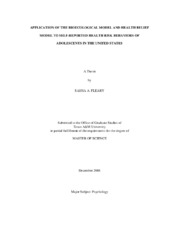| dc.description.abstract | Health risk behaviors are responsible for the majority of morbidity and mortality among adolescents. Researchers have identified three sources of risk-taking in adolescents – dispositional, ecological and biological. The Bioecological Model incorporates these three sources of risk-taking, however it lacks explanatory power. For this reason, this thesis focused on explaining risk perception of health risk behaviors (smoking cigarette, alcohol and marijuana use), and health risk behaviors by integrating the Bioecological Model with a more specific Health Belief Model. The relationship between risk perception and health risk behavior was also investigated as a first step in understanding adolescent decision-making using the Health Belief Model.
Adolescents from a suburban Indiana area were asked to complete the Adolescent Health Risk Behavior Survey which assessed egocentrism, self-esteem, social norms, risk perceptions, and the incidence and prevalence of health endangering behaviors. Hierarchical linear regression was used to determine the ability of the systems in the Bioecological Model and their specific variables to explain risk perception of health risk behaviors. Hierarchical logistic regression was used to determine the ability of the systems in the Bioecological Model and their specific variables to explain health risk behaviors and to moderate the relationships between risk perception and health risk behaviors.
Based on the results, it was confirmed that the Bioecological Model is important in understanding adolescent’s risk perception of health risk behaviors, and their self-reported health risk behaviors. It is also important in understanding the relationship between risk perception and health risk behaviors. Adolescent Variables, Microsystem, and Mesosystem were significant in predicting adolescent risk perception of all health risk behaviors examined, and self-reported smoking cigarette behavior and marijuana use. Adolescent variables and Microsystem were the only systems to predict adolescent self-reported alcohol use. The relationship between risk perception and reported smoking cigarette behavior was moderated by Adolescent Variables, Microsystem and Mesosystem, however for alcohol use the path was moderated by Adolescent Variables and for marijuana use the path was moderated by the Mesosytem. Results of this thesis imply the importance of considering the contribution of Bioecological Model variables when implementing prevention intervention programs specific to adolescent health risk behaviors. | en |


